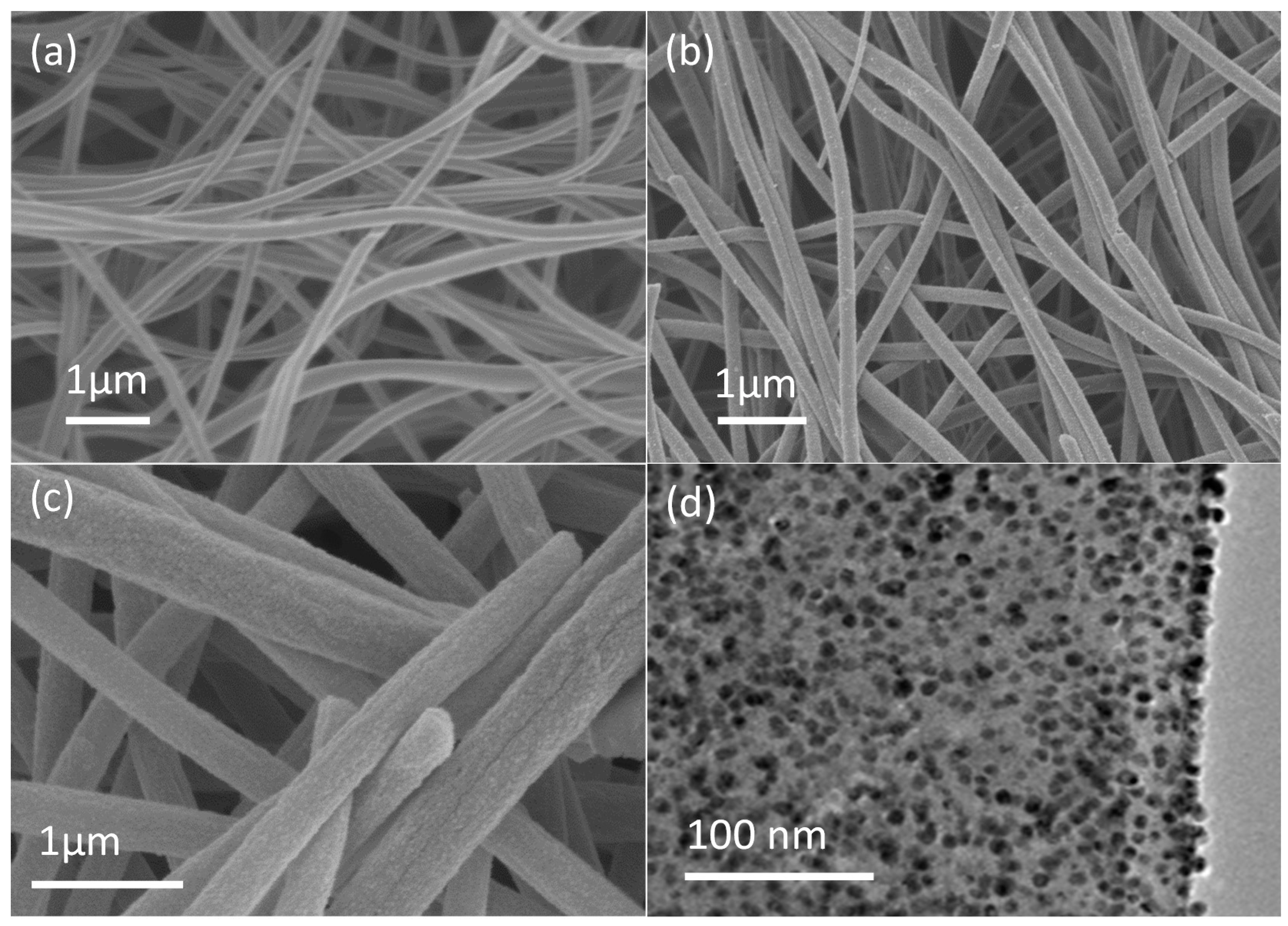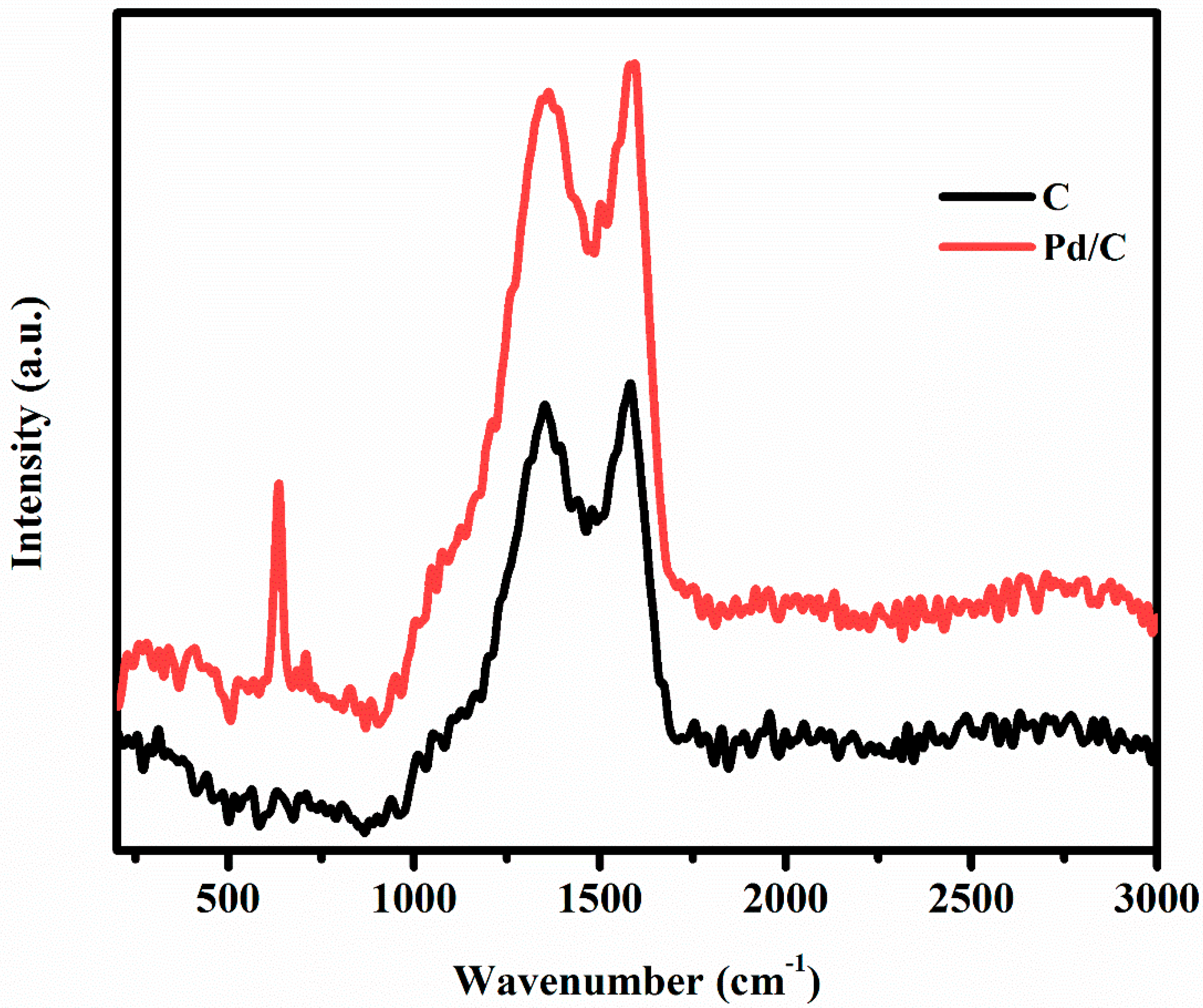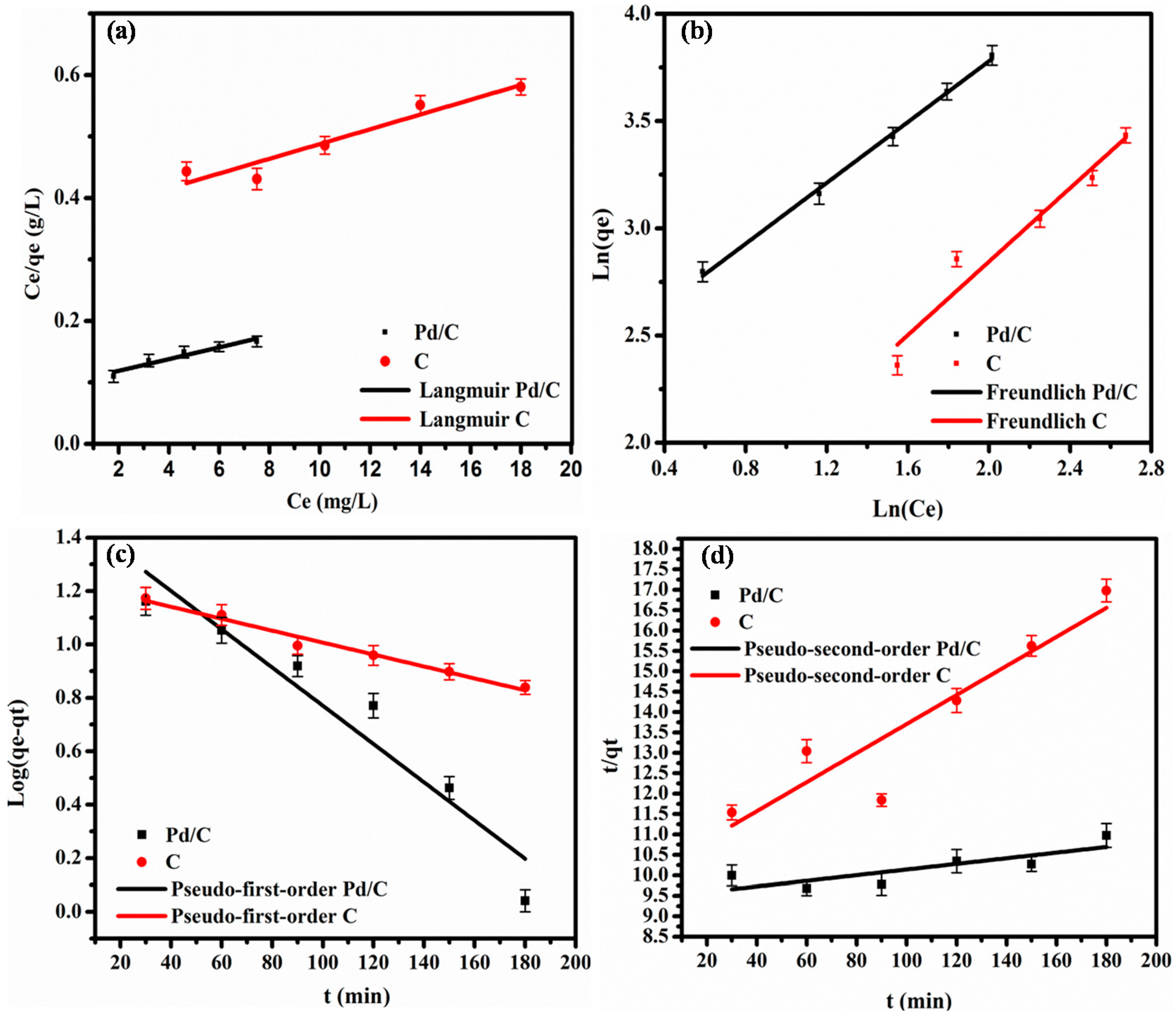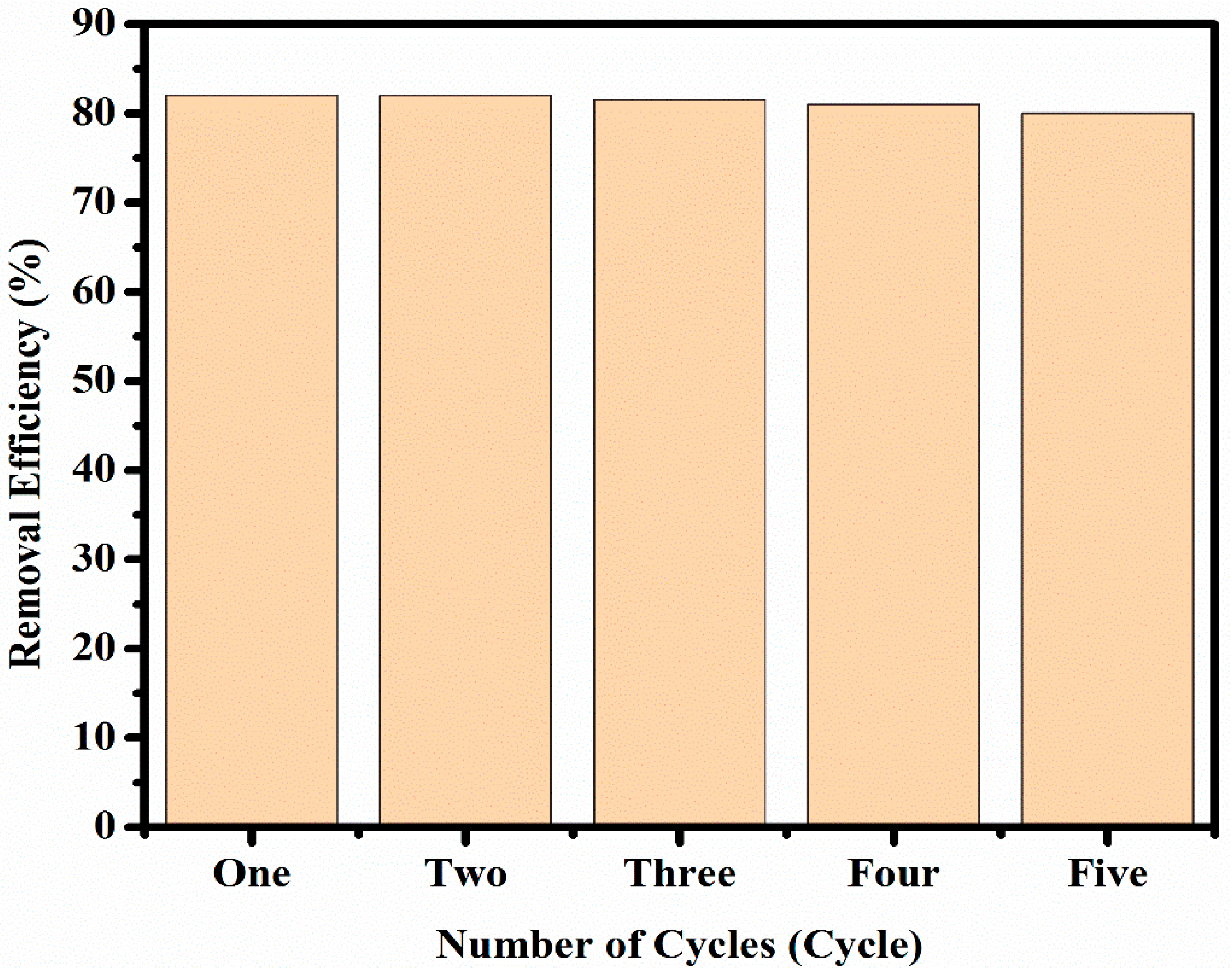Palladium/Carbon Nanofibers by Combining Atomic Layer Deposition and Electrospinning for Organic Pollutant Degradation
Abstract
1. Introduction
2. Materials and Methods
2.1. Chemicals
2.2. Synthesis of Palladium/Carbon Nanofibers
2.2.1. CNFs
2.2.2. ALD of Pd on CNFs
2.3. Characterization of Samples
2.4. Catalytic Activity
2.4.1. Adsorption Isotherms
2.4.2. Adsorption Kinetics
3. Results and Discussion
3.1. Characterization of Palladium/Carbon Nanofibers
3.1.1. Morphological Properties of CNFs and Pd/CNFs
3.1.2. Surface Properties of Pd/CNFs
3.1.3. CNF and Pd/CNF Structural Properties
3.2. Catalytic Activity Results
3.2.1. Isothermal Study
3.2.2. Kinetic Study
4. Conclusions
Supplementary Materials
Author Contributions
Funding
Conflicts of Interest
References
- Cano, O.A.; González, C.A.R.; Paz, J.F.H.; Madrid, P.A.; Casillas, P.E.G.; Hernández, A.L.M.; Pérez, C.A.M. Catalytic activity of palladium nanocubes/multiwalled carbon nanotubes structures for methyl orange dye removal. Catal. Today 2017, 282, 168–173. [Google Scholar] [CrossRef]
- Mendes, S.; Robalo, M.P.; Martins, L.O. Bacterial Enzymes and Multi-Enzymatic Systems for Cleaning-Up Dyes from the Environment. In Microbial Degradation of Synthetic Dyes in Wastewaters; Springer: Cham, Switzerland, 2015. [Google Scholar]
- Ajmal, A.; Majeed, I.; Malik, R.N.; Idriss, H.; Nadeem, M.A. Principles and mechanisms of photocatalytic dye degradation on TiO2 based photocatalysts: A comparative overview. RSC Adv. 2014, 4, 37003–37026. [Google Scholar] [CrossRef]
- Minati, L.; Aguey-Zinsou, K.F.; Micheli, V. Dalton Transactions. Dalt. Trans. 2018, 47, 14573–14579. [Google Scholar] [CrossRef] [PubMed]
- Moon, C.H.; Myung, N.V.; Haberer, E.D.; Moon, C.H.; Myung, N.V.; Haberer, E.D. Chemiresistive hydrogen gas sensors from gold-palladium nanopeapods Chemiresistive hydrogen gas sensors from gold-palladium nanopeapods. Appl. Phys. Lett. 2014, 105, 223102. [Google Scholar] [CrossRef]
- Zaluski, L.; Zaluska, A.; Strrm-olsen, J.O.; Schulz, R. Catalytic effect of Pd on hydrogen absorption in mechanically alloyed Mg2Nis, LaNi5 and FeTi. J. Alloys Compd. 1995, 217, 295–300. [Google Scholar] [CrossRef]
- Lee, E.; Min, J.; Hoon, J.; Lee, W.; Lee, T. Hysteresis behavior of electrical resistance in Pd thin films during the process of absorption and desorption of hydrogen gas. Int. J. Hydrog. Energy 2010, 35, 6984–6991. [Google Scholar] [CrossRef]
- Hughes, R.C.; Schubert, W.K.; Buss, R.J. Solid-State Hydrogen Sensors Using Palladium-Nickel Alloys: Effect of Alloy Composition on Sensor Response. J. Electrochem. Soc. 1995, 142, 249–254. [Google Scholar] [CrossRef]
- Meyer, N.; Devillers, M.; Hermans, S. Boron nitride supported Pd catalysts for the hydrogenation of lactose. Catal. Today 2015, 241, 200–207. [Google Scholar] [CrossRef]
- Adams, B.D.; Chen, A. The role of palladium in We are facing accelerated global warming due to the accumulation of. Mater. Today 2011, 14, 282–289. [Google Scholar] [CrossRef]
- Mackus, A.J.M.; Weber, M.J.; Thissen, N.F.W.; Garcia-Alonso, D.; Vervuurt, R.H.J.; Assali, S.; Bol, A.A.; Verheijen, M.A.; Kessels, W.M.M. Atomic layer deposition of Pd and Pt nanoparticles for catalysis: On the mechanisms of nanoparticle formation. Nanotechnology 2016, 27, 034001. [Google Scholar] [CrossRef]
- Lim, B.; Kobayashi, H.; Camargo, P.H.; Allard, L.F.; Liu, J.; Xia, Y. New Insights into the Growth Mechanism and Surface Structure of Palladium Nanocrystals. Nano Res. 2010, 3, 180–188. [Google Scholar] [CrossRef]
- Rikkinen, E.; Santasalo-Aarnio, A.; Airaksinen, S.; Borghei, M.; Viitanen, V.; Sainio, J.; Kauppinen, E.I.; Kallio, T.; Krause, A.O.I. Atomic Layer Deposition Preparation of Pd Nanoparticles on a Porous Carbon Support for Alcohol Oxidation. J. Phys. Chem. C 2011, 115, 23067–23073. [Google Scholar] [CrossRef]
- Li, S.; Li, H.; Liu, J.; Zhang, H.; Yang, Y.; Yang, Z.; Wang, B. Highly efficient degradation of organic dyes by palladium nanoparticles decorated on 2D magnetic reduced graphene oxide nanosheets. Dalt. Trans. 2015, 44, 9193–9199. [Google Scholar] [CrossRef] [PubMed]
- Weber, M.J.; Mackus, A.J.; Verheijen, M.A.; van der Marel, C.; Kessels, W.M. Supported Core/Shell Bimetallic Nanoparticles Synthesis by Atomic Layer Deposition. Chem. Mater. 2012, 24, 2973–2977. [Google Scholar] [CrossRef]
- Weber, M.; Julbe, A.; Ayral, A.; Miele, P.; Bechelany, M. Atomic Layer Deposition for Membranes: Basics, Challenges and Opportunities. Chem. Mater. 2018, 30, 7368–7390. [Google Scholar] [CrossRef]
- Graniel, O.; Weber, M.; Balme, S.; Miele, P.; Bechelany, M. Atomic Layer deposition for Biosening Application. Biosens. Bioelectron. 2018, 122, 147–159. [Google Scholar] [CrossRef]
- Elias, J.; Utke, I.; Yoon, S.; Bechelany, M.; Weidenkaff, A.; Michler, J.; Philippe, L. Electrochimica Acta Electrochemical growth of ZnO nanowires on atomic layer deposition coated polystyrene sphere templates. Electrochim. Acta 2013, 110, 387–392. [Google Scholar] [CrossRef]
- Ritala, M.; Kukli, K.; Rahtu, A.; Räisänen, P.I.; Leskelä, M.; Sajavaara, T.; Keinonen, J. Atomic layer deposition of oxide thin films with metal alkoxides as oxygen sources. Science 2000, 288, 319–321. [Google Scholar] [CrossRef]
- Hämäläinen, J.; Ritala, M.; Leskelä, M. Atomic layer deposition of noble metals and their oxides. Chem. Mater. 2013, 26, 786–801. [Google Scholar] [CrossRef]
- Kim, H. Atomic layer deposition of metal and nitride thin films: Current research efforts and applications for semiconductor device processing. J. Vac. Sci. Technol. B Microelectron. Nanom. Struct. Process. Meas. Phenom. 2003, 21, 2231–2261. [Google Scholar] [CrossRef]
- Weber, M.; Koonkaew, B.; Balme, S.; Utke, I.; Picaud, F.; Iatsunskyi, I.; Bechelany, M. Boron Nitride Nanoporous Membranes with High Surface Charge by Atomic Layer Deposition. ACS Appl. Mater. Interfaces 2017, 9, 16669–16678. [Google Scholar] [CrossRef]
- Aaltonen, T.; Ritala, M.; Tung, Y.L.; Chi, Y.; Arstila, K.; Meinander, K.; Leskelä, M. Atomic layer deposition of noble metals: Exploration of the low limit of the deposition temperature. J. Mater. Res. 2004, 19, 3353–3358. [Google Scholar] [CrossRef]
- Weber, M.J.; Mackus, A.J.M.; Verheijen, M.A.; Longo, V.; Bol, A.A.; Kessels, W.M.M. Atomic layer deposition of high-purity palladium films from Pd (hfac) 2 and H2 and O2 plasmas. J. Phys. Chem. C 2014, 118, 8702–8711. [Google Scholar] [CrossRef]
- Leskelä, M.; Ritala, M. Atomic layer deposition (ALD): From precursors to thin film structures. Thin Solid Films 2002, 409, 138–146. [Google Scholar] [CrossRef]
- Putkonen, M. Precursors for ALD Processes. In Atomic Layer Deposition of Nanostructured Materials; Wiley Online Library: Hoboken, NJ, USA, 2012; pp. 41–59. [Google Scholar]
- George, S.M. Atomic Layer Deposition: An Overview. Chem. Rev. 2010, 110, 111–131. [Google Scholar] [CrossRef] [PubMed]
- Marichy, C.; Bechelany, M.; Pinna, N. Atomic Layer Deposition of Nanostructured Materials for Energy and Environmental Applications. Adv. Mater. 2012, 24, 1017–1032. [Google Scholar] [CrossRef] [PubMed]
- Detavernier, C.; Dendooven, J.; Sree, S.P.; Ludwig, K.F.; Martens, J.A. Tailoring nanoporous materials by atomic layer deposition. Chem. Soc. Rev. 2011, 40, 5242–5253. [Google Scholar] [CrossRef]
- Van Bui, H.; Grillo, F.; van Ommen, J.R. Atomic and molecular layer deposition: Off the beaten track. Chem. Commun. 2017, 53, 45–71. [Google Scholar] [CrossRef]
- Raaijmakers, I.J. Current and Future Applications of ALD in Micro-electronics. ECS Trans. 2011, 41, 3–17. [Google Scholar]
- Parsons, G.N.; George, S.M.; Knez, M. Progress and future directions for atomic layer deposition and ALD-based chemistry. MRS Bull. 2011, 36, 865–871. [Google Scholar] [CrossRef]
- Yang, H.; Waldman, R.Z.; Chen, Z. Atomic layer deposition for membrane interface engineering. Nanoscale 2018, 10, 20505–20513. [Google Scholar] [CrossRef] [PubMed]
- Weber, M.; Drobek, M.; Rebière, B.; Charmette, C.; Cartier, J.; Julbe, A.; Bechelany, M. Hydrogen selective palladium-alumina composite membranes prepared by Atomic Layer Deposition. J. Membr. Sci. 2020, 596, 117701. [Google Scholar] [CrossRef]
- Weber, M.; Julbe, A.; Kim, S.S.; Bechelany, M. Atomic layer deposition (ALD) on inorganic or polymeric membranes Atomic layer deposition (ALD) on inorganic or polymeric membranes. J. Appl. Phys. 2019, 126, 41101. [Google Scholar] [CrossRef]
- Weber, M.; Collot, P.; el Gaddari, H.; Tingry, S.; Bechelany, M.; Holade, Y. Enhanced Catalytic Glycerol Oxidation Activity Enabled by Activated-Carbon-Supported Palladium Catalysts Prepared through Atomic Layer Deposition. ChemElectroChem 2018, 5, 743–747. [Google Scholar] [CrossRef]
- Barhoum, A.; El-Maghrabi, H.H.; Iatsunskyi, I.; Coy, E.; Renard, A.; Salameh, C.; Bechelany, M. Journal of Colloid and Interface Science Atomic layer deposition of Pd nanoparticles on self-supported carbon-Ni/NiO-Pd nanofiber electrodes for electrochemical hydrogen and oxygen evolution reactions. J. Colloid Interface Sci. 2020, 569, 286–297. [Google Scholar] [CrossRef]
- Weber, M.; Tuleushova, N.; Zgheib, J.; Lamboux, C.; Iatsunskyi, I.; Coy, E.; Bechelany, M.; Flaud, V.; Tingry, S.; Cornu, D.; et al. Enhanced electrocatalytic performance triggered by atomically bridged boron nitride between palladium nanoparticles and carbon fibers in gas-diffusion electrodes. Appl. Catal. B Environ. 2019, 257, 117917. [Google Scholar] [CrossRef]
- Nada, A.A.; Nasr, M.; Viter, R.; Miele, P.; Roualdes, S.; Bechelany, M. Mesoporous ZnFe2O4@TiO2 Nanofibers Prepared by Electrospinning Coupled to PECVD as Highly Performing Photocatalytic Materials. J. Phys. Chem. C 2017, 121, 24669–24677. [Google Scholar] [CrossRef]
- Wang, C.-H.; Chien, H.-S.; Hsu, C.-H.; Wang, Y.-C.; Wang, C.-T.; Lu, H.-A. Electrospinning of Polyacrylonitrile Solutions at Elevated Temperatures. Macromolecules 2007, 40, 7973–7983. [Google Scholar] [CrossRef]
- Wang, T.; Kumar, S. Electrospinning of Polyacrylonitrile Nanofibers. J. Appl. Polym. Sci. 2006, 102, 1023–1029. [Google Scholar] [CrossRef]
- Wu, M.; Wang, Q.; Li, K.; Wu, Y.; Liu, H. Optimization of stabilization conditions for electrospun polyacrylonitrile nano fi bers. Polym. Degrad. Stab. 2012, 97, 1511–1519. [Google Scholar] [CrossRef]
- Fennessey, S.F.; Farris, R.J. Fabrication of aligned and molecularly oriented electrospun polyacrylonitrile nanofibers and the mechanical behavior of their twisted yarns. Polym. Degrad. Stab. 2004, 45, 4217–4225. [Google Scholar] [CrossRef]
- Hou, H.; Ge, J.J.; Zeng, J.; Li, Q.; Reneker, D.H.; Greiner, A.; Cheng, S.Z. Electrospun Polyacrylonitrile Nanofibers Containing a High Concentration of Well-Aligned Multiwall Carbon Nanotubes. Chem. Mater. 2005, 17, 967–973. [Google Scholar] [CrossRef]
- Engel, A.B.; Cherifi, A.; Bechelany, M.; Tingry, S.; Cornu, D. Control of Spatial Organization of Electrospun Fibers in a Carbon Felt for Enhanced Bioelectrode Performance. Chempluschem 2015, 80, 494–502. [Google Scholar] [CrossRef] [PubMed]
- Nasouri, K.; Shoushtari, A.M.; Kaflou, A. Investigation of polyacrylonitrile electrospun nanofibres morphology as a function of polymer concentration, viscosity and Berry number. Micro Nano Lett. 2012, 7, 423–426. [Google Scholar] [CrossRef]
- Barhoum, A.; Pal, K.; Rahier, H.; Uludag, H.; Soo, I. Nanofibers as new-generation materials: From spinning and nano-spinning fabrication techniques to emerging applications. Appl. Mater. Today 2019, 17, 1–35. [Google Scholar] [CrossRef]
- Nagarajan, S.; Belaid, H.; Pochat-Bohatier, C.; Teyssier, C.; Iatsunskyi, I.; Coy, E.; Balme, S.; Cornu, D.; Miele, P.; Kalkura, N.S.; et al. Design of Boron Nitride/Gelatin Electrospun Nanofibers for Bone Tissue Engineering. ACS Appl. Mater. Interfaces 2017, 9, 33695–33706. [Google Scholar] [CrossRef]
- Gugulothu, D.; Barhoum, A.; Nerella, R.; Ajmer, R.; Bechelany, M. Fabrication of Nanofibers: Electrospinning and Non-Electrospinning Techniques. In Handbook of Nanofibers; Springer: Cham, Switzerland, 2019. [Google Scholar]
- Rahaman, M.S.A.; Ismail, A.F.; Mustafa, A. A review of heat treatment on polyacrylonitrile fiber. Polym. Degrad. Stab. 2007, 92, 1421–1432. [Google Scholar] [CrossRef]
- Zhang, L.; Aboagye, A.; Kelkar, A. A review: Carbon nanofibers from electrospun polyacrylonitrile and their applications. J. Mater. Sci. 2014, 49, 463–480. [Google Scholar] [CrossRef]
- Sapountzi, E.; Braiek, M.; Chateaux, J.F.; Jaffrezic-Renault, N.; Lagarde, F. Recent Advances in Electrospun Nanofiber Interfaces for Biosensing Devices. Sensors 2017, 17, 1887. [Google Scholar] [CrossRef]
- Sundarrajan, S.; Luck, K.; Huat, S.; Ramakrishna, S. Electrospun Nanofibers for Air Filtration Applications. Procedia Eng. 2014, 75, 159–163. [Google Scholar] [CrossRef]
- Lahav, M.; Weiss, E.A.; Xu, Q.; Whitesides, G.M. Core—Shell and Segmented Polymer—Metal Composite Nanostructures. Nano Lett. 2006, 9, 2166–2171. [Google Scholar] [CrossRef] [PubMed]
- Caruso, B.R.A.; Schattka, J.H.; The, A.G. Titanium dioxide tubes from sol–gel coating of electrospun polymer fibers. Adv. Materv 2001, 13, 1577–1579. [Google Scholar] [CrossRef]
- Hou, H.; Jun, Z.; Reuning, A.; Schaper, A.; Wendorff, J.H.; Greiner, A. Poly (p-xylylene) nanotubes by coating and removal of ultrathin polymer template fibers. Macromolecules 2002, 35, 2429–2431. [Google Scholar] [CrossRef]
- Wnek, G.E.; Carr, M.E.; Simpson, D.G.; Bowlin, G.L. Electrospinning of Nanofiber Fibrinogen Structures. Nano Lett. 2003, 3, 213–216. [Google Scholar] [CrossRef]
- Kenawy, E.R.; Bowlin, G.L.; Mansfield, K.; Layman, J.; Simpson, D.G.; Sanders, E.H.; Wnek, G.E. Release of tetracycline hydrochloride from electrospun poly (ethylene-co-vinylacetate), poly (lactic acid), and a blend. J. Control. Release 2002, 81, 57–64. [Google Scholar] [CrossRef]
- SSchreuder-Gibson, H.; Gibson, P.; Senecal, K.; Sennett, M.; Walker, J. Protective Textile Materials Based on Electrospun Nanofibers Protective Materials Based on Electrospun Nanofibers. J. Adv. Mater. 2002, 34, 44–55. [Google Scholar]
- Park, H.; Park, Y.O. Filtration Properties of Electrospun Ultrafine Fiber Webs. Korean J. Chem. Eng. 2005, 22, 165–172. [Google Scholar] [CrossRef]
- Choi, S.W.; Jo, S.M.; Lee, W.S.; Kim, Y.R. An electrospun poly (vinylidene fluoride) nanofibrous membrane and its battery applications. Adv. Mater. 2003, 15, 2027–2032. [Google Scholar] [CrossRef]
- Kim, C.; Yang, K.S. Electrochemical properties of carbon nanofiber web as an electrode for supercapacitor prepared by electrospinning. Appl. Phys. Lett. 2003, 83, 1216–1218. [Google Scholar] [CrossRef]
- Jia, X.; Wang, J.; Wu, J.; Du, Y.; Zhao, B.; den Engelsen, D. Bouquet-like calcium sulfate dihydrate: A highly efficient adsorbent for Congo red dye. RSC Adv. 2015, 5, 72321–72330. [Google Scholar] [CrossRef]
- Nada, A.A.; Bekheet, M.F.; Roualdes, S.; Gurlo, A.; Ayral, A. Functionalization of MCM-41 with titanium oxynitride deposited via PECVD for enhanced removal of methylene blue. J. Mol. Liq. 2019, 274, 505–515. [Google Scholar] [CrossRef]
- Chen, S.; Zhang, J.; Zhang, C.; Yue, Q.; Li, Y.; Li, C. Equilibrium and kinetic studies of methyl orange and methyl violet adsorption on activated carbon derived from Phragmites australis. Desalination 2010, 252, 149–156. [Google Scholar] [CrossRef]
- Yao, Y.; He, B.; Xu, F.; Chen, X. Equilibrium and kinetic studies of methyl orange adsorption on multiwalled carbon nanotubes. Chem. Eng. J. 2011, 170, 82–89. [Google Scholar] [CrossRef]
- Chin, Y.C.; Iglesia, E. Dynamics and thermodynamics of Pd–PdO phase transitions: Effects of Pd cluster size and kinetic implications for catalytic methane combustion. J. Phys. Chem. C 2016, 120, 1446–1460. [Google Scholar] [CrossRef]
- Weber, W.H.; Baird, R.J.; Graham, G.W. Raman investigation of palladium oxide, rhodium sesquioxide and palladium rhodium dioxide. J. Raman Spectrosc. 1988, 19, 239–244. [Google Scholar] [CrossRef]
- Mcbride, J.R.; Hass, K.C.; Et Weber, W.H. Resonance-Raman and lattice-dynamics studies of single-crystal PdO. Phys. Rev. B 1991, 44, 5016. [Google Scholar] [CrossRef]
- Seo, D.K.; Jeun, J.P.; Kim, H.B.; Kang, P.H. Preparation and characterization of the carbon nanofiber mat produced from electrospun PAN/lignin precursors by electron beam irradiation. Rev. Adv. Mater. Sci. 2011, 28, 31–34. [Google Scholar]
- Huang, B.J.; Wang, D.; Hou, H.; You, T. Electrospun palladium nanoparticle-loaded carbon nanofibers and their electrocatalytic activities towards hydrogen peroxide and NADH. Adv. Funct. Mater. 2008, 18, 441–448. [Google Scholar] [CrossRef]
- Ma, X.; Liu, S.; Liu, Y.; Gu, G.; Xia, C. Comparative study on catalytic hydrodehalogenation of halogenated aromatic compounds over Pd/C and Raney Ni catalysts. Sci. Rep. 2016, 6, 25068. [Google Scholar] [CrossRef] [PubMed]
- Du, L.; Wu, J.; Qin, S.; Hu, C. Degradation mechanism of Methyl Orange by electrochemical process on RuOx − PdO/Ti electrode. Water Sci. Technol. 2011, 63, 1539–1545. [Google Scholar] [CrossRef] [PubMed]
- Chen, T.; Zheng, Y.; Lin, J.M.; Chen, G. Study on the photocatalytic degradation of methyl orange in water using Ag/ZnO as catalyst by liquid chromatography electrospray ionization ion-trap mass spectrometry. J. Am. Soc. Mass Spectrom. 2008, 19, 997–1003. [Google Scholar] [CrossRef] [PubMed]
- Szeto, W.; Kan, C.W.; Yuen, C.W.M.; Chan, S.-W.; Lam, K.H. Effective Photodegradation of Methyl Orange Using Fluidized Bed Reactor Loaded with Cross-Linked Chitosan Embedded Nano-CdS Photocatalyst. Int. J. Chem. Eng. 2014, 2014, 1–16. [Google Scholar] [CrossRef]
- Mondal, A.; Adhikary, B.; Mukherjee, D. Room-temperature synthesis of air stable cobalt nanoparticles and their use as catalyst for methyl orange dye degradation. Colloids Surf. A Physicochem. Eng. Asp. 2015, 482, 248–257. [Google Scholar] [CrossRef]
- Islam, T.; Saenz-Arana, R.; Wang, H.; Bernal, R.; Noveron, J.C. Green synthesis of gold, silver, platinum, and palladium nanoparticles reduced and stabilized by sodium rhodizonate and their catalytic reduction of 4-nitrophenol and methyl orange. New J. Chem. 2018, 42, 6472–6478. [Google Scholar] [CrossRef]
- Shuai, D.; Chaplin, B.P.; Shapley, J.R.; Menendez, N.P.; McCalman, D.C.; Schneider, W.F.; Werth, C.J. Enhancement of Oxyanion and Diatrizoate Reduction Kinetics Using Selected Azo Dyes on Pd-Based Catalysts. Environ. Sci. Technol. 2010, 44, 1773–1779. [Google Scholar] [CrossRef]
- Bashir, M.S.; Jiang, X.; Kong, X.Z. Porous polyurea microspheres with Pd immobilized on surface and their catalytic activity in 4-nitrophenol reduction and organic dyes degradation. Eur. Polym. J. 2020, 129, 109652. [Google Scholar] [CrossRef]
- Zhao, Z.; Ma, X.; Wang, X.; Ma, Y.; Liu, C.; Hang, H.; Zhang, Y.; Du, Y.; Ye, W. Synthesis of amorphous PdP nanoparticles supported on carbon nanospheres for 4-nitrophenol reduction in environmental applications. Appl. Surf. Sci. 2018, 457, 1009–1017. [Google Scholar] [CrossRef]
- Narasaiah, B.P.; Mandal, B.K. Remediation of azo-dyes based toxicity by agro-waste cotton boll peels mediated palladium nanoparticles. J. Saudi Chem. Soc. 2020, 24, 267–281. [Google Scholar] [CrossRef]
- Jaleh, B.; Karami, S.; Sajjadi, M.; Mohazzab, B.F.; Azizian, S.; Nasrollahzadeh, M.; Varma, R.S. Chemosphere Laser-assisted preparation of Pd nanoparticles on carbon cloth for the degradation of environmental pollutants in aqueous medium. Chemosphere 2020, 246, 125755. [Google Scholar] [CrossRef]
- Javaid, R.; Et Qazi, U.Y. Catalytic Oxidation Process for the Degradation of Synthetic Dyes: An Overview. Int. J. Environ. Res. Public Health 2019, 16, 2066. [Google Scholar] [CrossRef]
- Riga, A.; Soutsas, K.; Ntampegliotis, K.; Karayannis, V.; Papapolymerou, G. Effect of system parameters and of inorganic salts on the decolorization and degradation of Procion H-exl dyes. Comparison of H2O2/UV, Fenton, UV/Fenton, TiO2/UV and TiO2/UV/H2O2 processes. Desalination 2007, 211, 72–86. [Google Scholar] [CrossRef]
- Roy, M.; Mondal, A.; Mondal, A.; Das, A.; Mukherjee, D. Polyaniline Supported Palladium Catalyzed Reductive Degradation of Dyes Under Mild Condition. Curr. Green Chem. 2019, 6, 69–75. [Google Scholar] [CrossRef]
- Choi, S.; Jeong, Y.; Yu, J. Spontaneous hydrolysis of borohydride required before its catalytic activation by metal nanoparticles. Catal. Commun. 2016, 84, 80–84. [Google Scholar] [CrossRef]








| Model | Parameter | Value | |
|---|---|---|---|
| Langmuir | Pd/C | qmax (mg/g) | 104 |
| KL (L/mg) | 0.0960 | ||
| R2 | 0.932 | ||
| C | qmax (mg/g) | 83 | |
| KL (L/mg) | 0.0326 | ||
| R2 | 0.922 | ||
| Freundlich | Pd/C | KF ((mg/g)(L/mg)1/n) | 10.60 |
| n | 1.41 | ||
| R2 | 0.998 | ||
| C | KF ((mg/g)(L/mg)1/n) | 3.10 | |
| n | 1.17 | ||
| R2 | 0.950 | ||
| Model | Parameter | Value | |
|---|---|---|---|
| Pseudo-first-order | Pd/C | qe (cal) (mg/g) | 30.7 |
| K1 (1/min) × 10−2 | 1.7 | ||
| R2 | 0.92 | ||
| C | qe (cal) (mg/g) | 17.0 | |
| K1 (1/min) × 10−3 | 5.1 | ||
| R2 | 0.98 | ||
| Pseudo-second-order | Pd/C | qe (cal) (mg/g) | 144.9 |
| K2 (g/(mg·min)) × 10−6 | 5.0 | ||
| R2 | 0.67 | ||
| C | qe (cal) (mg/g) | 28.1 | |
| K2 (g/(mg·min)) × 10−6 | 124.9 | ||
| R2 | 0.86 | ||
| Catalyst | Catalyst Concentration (M) | Dye | Pd Size (nm) | (wt% Pd) | Degradation Time (Optimal) | Removal Efficiency (%) | Ref. |
|---|---|---|---|---|---|---|---|
| Pd supported on Carbon nanotubes | 1.879 × 10−3 | Methyl orange | 15 to 25 | 17.7 | 60 min | 99.31 | [1] |
| Pd/Fe3O4-PEI-RGO | 0.5 × 10−7 | Methylene Blue | 4.5 | 1.9 | 10 min | 99 | [14] |
| Pd/porous polyurea microsphere | 0.52 × 10−4 | 4-NP nitrophenol | 3.5 | 1.76 | 6 min | 96 | [79] |
| Pd/Carbon nanospheres | 0.018 | 4-Nitrophenol | 7 | 1.3 | 49 min | 95 | [80] |
| Pd NPs | 9.42 × 10−3 | Congo Red CR | 12 | 9.2 | 14 min | 95 | [81] |
| Pd NPs | 9.42 × 10−3 | Sunset Yellow | 21 | 9.2 | 9 min | 97 | [81] |
| Pd NPs | 9.42 × 10−3 | Methyl Orange | 12 | 9.2 | 12 min | 96 | [81] |
| Pd NPs | 9.42 × 10−3 | Tartrazine | 12 | 9.2 | 12 min | 96 | [81] |
| Pd/Carbon Cloth | 1.688 × 10−3 | 4-Nitrophenol | 95 | 1.9 | 7 min | 94 | [82] |
| Pd/Carbon Cloth | 1.688 × 10−3 | Congo Red | 95 | 1.9 | 2 min | 94 | [82] |
| Pd/Carbon Cloth | 1.18 × 10−3 | Methylene Blue | 95 | 1.9 | 3s | 94 | [82] |
| Pd/CNFs | 0.016 | Methyl Orange | 7 | 8.33.2 | 240 min | 98.9 | This work |
© 2020 by the authors. Licensee MDPI, Basel, Switzerland. This article is an open access article distributed under the terms and conditions of the Creative Commons Attribution (CC BY) license (http://creativecommons.org/licenses/by/4.0/).
Share and Cite
Najem, M.; Nada, A.A.; Weber, M.; Sayegh, S.; Razzouk, A.; Salameh, C.; Eid, C.; Bechelany, M. Palladium/Carbon Nanofibers by Combining Atomic Layer Deposition and Electrospinning for Organic Pollutant Degradation. Materials 2020, 13, 1947. https://doi.org/10.3390/ma13081947
Najem M, Nada AA, Weber M, Sayegh S, Razzouk A, Salameh C, Eid C, Bechelany M. Palladium/Carbon Nanofibers by Combining Atomic Layer Deposition and Electrospinning for Organic Pollutant Degradation. Materials. 2020; 13(8):1947. https://doi.org/10.3390/ma13081947
Chicago/Turabian StyleNajem, Melissa, Amr A. Nada, Matthieu Weber, Syreina Sayegh, Antonio Razzouk, Chrystelle Salameh, Cynthia Eid, and Mikhael Bechelany. 2020. "Palladium/Carbon Nanofibers by Combining Atomic Layer Deposition and Electrospinning for Organic Pollutant Degradation" Materials 13, no. 8: 1947. https://doi.org/10.3390/ma13081947
APA StyleNajem, M., Nada, A. A., Weber, M., Sayegh, S., Razzouk, A., Salameh, C., Eid, C., & Bechelany, M. (2020). Palladium/Carbon Nanofibers by Combining Atomic Layer Deposition and Electrospinning for Organic Pollutant Degradation. Materials, 13(8), 1947. https://doi.org/10.3390/ma13081947








